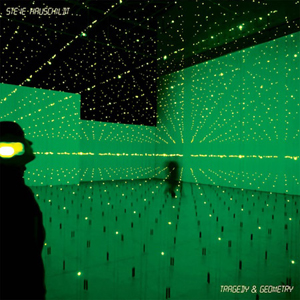Steve Hauschildt Tragedy & Geometry
One inherent element of most ambient music—of the electronic variety, specifically—is the lack of distinct […]

One inherent element of most ambient music—of the electronic variety, specifically—is the lack of distinct rhythms. At the most, artists will infuse their compositions with extremely loose rhythms, which can prove to be an ideal approach for creating surreal and immersive sound worlds. Synth noodler Oneohtrix Point Never is certainly no stranger to ambling melodies (both LPs Rifts and Returnal are comprised almost entirely of drifting washes of Juno 60 tones), nor is Blanck Mass, the solo moniker of Benjamin Power from Fuck Buttons. Steve Hauschildt, who also devotes his time to Cleveland trio Emeralds, is another like-minded auteur of analog electronics and cosmic soundscapes. He’s also an avid lover of transportive, kosmiche-style rhythms, and deftly infuses much of his latest synth-driven solo album, Tragedy & Geometry, with the hypnotic churn of those sounds. Suffice it to say, the combination’s results are nothing short of excellent.
Particular standouts of the 14 tracks that make up Hauschildt’s hour-long LP include the brightly colored and deeply emotive “Already Replaced,” the awe-inspiring expanse of centerpiece “Music For a Moire Pattern,” and the lush, shape-shifting title track. On those songs, the artist transforms what might otherwise be formless clouds of plinking melodies and deep synth chords into illuminating explorations of the subconscious, a feat that is achieved merely with the use of swirling, polyrhythmic arpeggiators and subtle drum machine sounds. The propulsive backbone that those elements provide immensely helps in setting Tragedy & Geometry apart from its peers and creating a much more satisfying listen, as it feels like you’re actually in the midst of a long sonic journey with every rise and fall of the eclectic tracklist.
There are moments of repose scattered throughout the album, too, some of which are as equally sublime as the more structured pieces. “Allegiance,” a mysterious lilt of bubbly electronics and cavernous synth moans, is one such moment, as is the woozy “Cupid’s Dart” and the densely layered “Peroxide.” These kinds of meandering productions closely resemble the beauty of songs like “Science Center” and “Summerdata” from Emeralds’ highly memorable 2010 LP, Does it Look Like I’m Here?, while simultaneously maintaining their own unique edge. And even though Tragedy & Geometry may not reach as wide an audience as Emeralds has (never underestimate the power of a little bit of guitar noodling), Hauschildt’s new opus is certainly just as captivating and varied as some of his band’s best work. Any fan of one would do well to hear the other.

